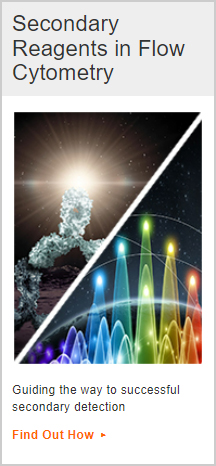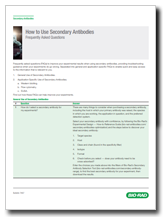How to Use Secondary Antibodies - FAQs & Troubleshooting
Frequently asked questions (FAQs) to improve your experimental results when using secondary antibodies, providing troubleshooting guidance when your experiments do go wrong.
Separated into general and application-specific FAQs to enable quick and easy access to the information that is relevant to you.
Find out how these FAQs can help improve your experiments.
General Use Secondary Antibody Questions
Q1: How do I select a secondary antibody for my experiments?
There are many things to consider when purchasing a secondary antibody, including the host in which your primary antibody was raised, the species in which you are working, the application in question, and the preferred detection system.
Select your secondary antibody with confidence, by following the Bio-Rad’s Experimental Design — How-to Reference Guide and the steps below to discover your ideal secondary antibody.
- Target species.
- Host.
- Class and chain (found in the specificity filter).
- Isotype.
- Format.
- Check before you select — does your antibody need to be cross-adsorbed?.
Enter the choices you made above into the filters of Bio-Rad’s Secondary Antibody Selection Tool, to find the best secondary antibody for your experiment, then download the results.
Q2: How do I decide which detection reagent/label to use?
When selecting a detection reagent, there are several things to consider:
-
Application.
- ELISA, by definition, requires the use of enzyme-labeled secondary antibodies
- Flow cytometry requires the use of fluorescently-labeled secondary antibodies
- Western blotting requires either enzyme-labeled or fluorescently-labeled secondary antibodies
- Immunohistology can use enzyme-labeled secondary antibodies (IHC) or fluorescently-labeled secondary antibodies (IF)
-
Detection equipment.
- Fluorescently-labeled secondary antibodies require imaging equipment that can detect and measure fluorescence
-
Enzyme-labeled secondary antibodies can use substrates that can be either:
- Colored and measured by absorbance or interpreted by eye
- Chemiluminescent and measured using a luminometer
- Chemifluorescent and measured using a fluorimeter
-
Sensitivity.
- For enzymes such as HRP, chemiluminescent substrates are usually more sensitive than the colorimetric substrates for ELISAs and western blots. However, for western blots, a colorimetric substrate gives a storable, qualitative record without the need for an instrument to visualize the blot. Likewise, it also gives a permanent record for IHC that can be observed with a simple microscope
- Fluorescently-labeled secondary antibodies have improved to approach the sensitivity of chemiluminescence in western blots for example, and can offer advantages in more reliable quantification of bands
-
Multiplexing.
- While a combination of enzyme-labeled secondary antibodies, like HRP and AP, can be used to generate dual-color images for immunohistology and western blotting, it is generally accepted that the use of fluorescently-labeled secondary antibodies are more amenable to multiplexing
Q3: How can I ensure that my secondary antibody will only bind the target primary antibody?
To prevent cross-reactivity and increase specificity, select a secondary antibody that has been:
- Cross-adsorbed against other species than the primary antibody host species
- Raised against the isotype of your primary antibody. If using more than one primary antibody, ensure that they are of a different isotype
Q4: Why should I choose a cross-adsorbed secondary antibody?
The benefits of cross-adsorbed secondary antibodies are:
- Minimize nonspecific background — no binding of the secondary antibodies to nontarget immunoglobulin
- Compatible with multiplex experiments — no unwanted binding to other primary antibodies used in multiplexing
Q5: What buffer should I dilute my secondary antibody in? Does it matter?
Generally it makes sense to dilute the secondary antibody or reagent in the same buffer used for the primary antibody, including any appropriate additions such as blocking proteins or detergents.
Care is needed as different constituents of a buffer can have a direct impact on the result of your experiment. Always ensure that the buffer used is compatible. For instance, the detection enzyme HRP is inhibited by sodium azide.
Q6: Why not use a primary antibody directly labeled with a detection reagent, rather than a secondary antibody?
Sometimes the primary antibody you have selected is not available with the label that you require. One solution could be to conjugate the primary antibody using a conjugation kit such as a LYNX or ReadiLink Conjugation Kit. However, there may be occasions when this approach is not practical; there may be a limited amount of antibody available, the antibody may be impure or contain a carrier protein, critical amino acids at the antigen binding site may be disrupted by conjugation, or in the case of screening hybridomas, there may simply be too many antibodies. In this situation, indirect staining using a secondary antibody is invaluable for detecting your marker.
Q7: Do I need to optimize the concentration of the secondary antibody as well as the primary antibody?
Secondary antibody concentration optimization is important to generate the maximum dynamic range between the positive and negative signal:
- Low antibody concentration will lower the nonspecific signal but may decrease the maximum signal
- High concentrations will maximize the positive signal but increase the nonspecific signal
Antibody datasheets will usually suggest a dilution range for the application being used. The optimal range will depend on the experiment and can only be determined empirically.
To optimize both the primary and secondary reagents, a matrix approach is best; for both the primary and secondary antibodies, prepare the antibody titrations by doing up to five doubling dilutions so that the recommended dilution falls in the mid range.
Q8: I am using a biotin-conjugated primary antibody with HRP-conjugated streptavidin. Is there a particular blocking buffer you would recommend?
It is recommended that you do not use milk with a streptavidin-biotin detection system, as milk contains biotin, which can result in high background; use a synthetic blocking buffer instead.
Q9: I am not seeing any positive signal from my primary antibody in my samples even in my positive control. I have used this primary antibody successfully in the past using my protocol, but I had to use a different secondary antibody. Could this be an issue with the secondary antibody I am now using?
Use the following as a checklist to identify where something may have gone wrong:
- Ensure that you follow the manufacturer's recommended storage and avoid freeze/thaw cycles for your secondary antibody.
- Confirm that the secondary antibody being used has been raised against the correct immunoglobulin from the host species of the primary antibody you are targeting (for instance if the primary antibody was raised in rabbit, then use an anti-rabbit secondary antibody).
- If you are using an HRP-conjugated secondary antibody, it is also important to ensure that the buffers used do not contain azide as this will inhibit HRP activity.
- If you are using an alkaline phosphatase-conjugated secondary antibody, do not use buffers containing phosphate as these will inhibit enzyme activity.
- Ensure you have the correct substrate for your enzyme-conjugated secondary antibody.
- Reduce the amount of detergent in the buffer you are using to dilute your secondary antibodies, as this may be inhibiting detection.
- For fluorescently-labeled secondary antibodies, make sure that the correct excitation and emission wavelengths have been selected for detection.
Western Blot Secondary Antibody Questions
Q10: What are the options to avoid stripping and reprobing my blot?
Stripping and reprobing of blots is a time consuming process that can have a negative impact on signal quality. A common reason for reprobing is to normalize lane loadings to allow quantification of targets. This can be avoided by using:
- Bio-Rad Strain-Free Gels; following transfer to the membrane, the total protein content of each lane can be quantified on a ChemiDoc Imaging System to allow confident lane-to-lane comparisons
- An antibody raised against a housekeeping gene (such as beta actin) can be used with a fluorescently labeled secondary antibody as a loading control alongside chemiluminescent detection of the antigen of interest
For simultaneous detection of two or more antibodies (multiplexing), the antibodies must be either:
- Directly labeled or,
- Detectable by using secondary antibodies that can distinguish the primary antibody by virtue of species, class, or isotype
A combination of tactics can be used; mixing direct and indirect labeling, fluorescence and chemiluminescence, and biotin/streptavidin with secondary antibodies. Thus, by careful choice of the antibody and detection reagent, it is possible to reduce the need to strip and reprobe your blot.
Q11: I have generated lysates from some rat spleen tissue and am looking to use a mouse primary antibody. How can I avoid extra bands from the secondary antibody detecting the heavy and light chain of the endogenous IgG within my lysates?
Select a secondary antibody raised against mouse IgG that has been cross-adsorbed against rat IgG. Alternatively, use a reagent that only detects an antibody in its native conformation (i.e. your primary antibody) but not in its denatured form (i.e. rat IgG within your sample) — for example, TidyBlot Reagent.
Q12: I am seeing additional bands in my secondary antibody-only control lanes. How can I reduce the nonspecific binding of my secondary antibody?
There are several steps that you can take to improve specific staining:
- Reduce the concentration of the secondary antibody. Titration experiments should be performed to optimize the concentration of the secondary antibody, as well as the primary antibody, for your experimental setup.
- Ensure your secondary antibody has been cross-adsorbed against immunoglobulin from the host species of your samples.
-
Optimize the blocking reagent your secondary antibody is diluted in:
- Add a detergent such as Tween 20 to your blocking buffer; be aware that if the concentration of Tween 20 in your blocking buffer is too high, it can strip proteins off the membrane (a concentration of 0.05% is usually sufficient)
- Increase the concentration of protein in your blocking buffer using a different blocking reagent. For example, if you are blocking with BSA, you could try milk powder or a synthetic blocking reagent instead
-
Optimize your wash steps and wash buffer:
- Increase the number of wash steps you are performing after the secondary antibody incubation and the length of time you are performing them for
- Increase the concentration of detergent in your wash buffer
- Ensure that you are performing your wash steps in a sufficient volume of wash buffer
Q13: Is it possible to use an unconjugated mouse primary antibody, with an anti-mouse IgG secondary antibody, for the detection of a target protein on mouse spleen tissue samples, without detecting the heavy and light chains from the endogenous IgG in my samples?
Use a western blot secondary detection reagent that only detects antibody in its native conformation (i.e. the primary antibody you are using to perform your western blot) and not in a denatured conformation (i.e. any endogenous IgG present in your sample) such as TidyBlot Reagent. However, you would need to check that the isotype of the mouse primary antibody you are using to perform your western blot is compatible.
Q14: I am conducting an IP using an antibody with a host species of mouse and wish to detect my target protein via western blot. I want to use a different primary antibody with a different host species to the antibody that I used to perform my IP, to avoid detection of the heavy and light chains from my IP antibody. However, my only option appears to be rat antibodies. Is this appropriate or will I see cross-reactivity from my anti-rat IgG secondary antibody with the mouse primary antibody I used to perform my IP?
It is possible to use a rat primary antibody and an anti-rat IgG secondary antibody, to detect a target protein on samples generated from an IP performed with a mouse antibody, without detecting the heavy and light chains from the mouse antibody used to perform the IP. However, you would need to ensure that the anti-rat IgG secondary antibody has been cross-adsorbed against mouse IgG. You could also consider purchasing a western blot secondary detection reagent that only detects antibody in its native conformation (i.e. the primary antibody you are using to perform your western blot) and not in a denatured conformation (i.e. any antibody that has been eluted into your IP sample) such as TidyBlot Reagent. However, you would need to check that the isotype of the mouse primary antibody you are using to perform your western blot is compatible.
Q15: How do you choose secondary antibodies for a multiplex fluorescent western blot experiment?
There are many things to consider when selecting a secondary antibody for use in western blotting multiplexing:
- Know your imager; ensure that the fluorophores selected are suitable for detection by your imager.
-
Select fluorophores which have different emission spectra. A spectraviewer should be used to ensure that the fluorophores selected have little to no spectral overlap. Bio-Rad offers a free spectraviewer tool at:
bio-rad-antibodies.com/spectraviewer. - It is important to use your brightest fluorophore to detect your least abundant target, whereas most fluorophores can be used to detect highly abundant targets.
- Autofluorescence can be problematic at shorter wavelengths of excitation and emission, but this is less of an issue above wavelengths of 550 nm. Bear this in mind when assigning fluorophores to avoid a decrease in the signal-to-noise ratio.
Q16: I am looking to perform a multiplex experiment but the only antibodies I can find against my target proteins are unconjugated mouse antibodies. Is there a way to do a multiplex experiment with these antibodies or will I have to strip and reprobe the blot?
Check whether the antibodies are of different isotypes and/or classes. If they are, you could use an isotype and/or class-specific secondary antibody that specifically targets each of the antibodies you are using. Bio-Rad’s recombinant monoclonal isotype-specific secondary antibodies directed against the three main mouse IgG isotypes, IgG1, IgG2a, and IgG2b are an alternative to cross-adsorbed secondary antibodies. They are capable of detecting individual isotypes without any species or isotype cross-reactivity, enabling unlabeled mouse monoclonal antibodies of differing IgG isotype to be used simultaneously. Multiplexing without species issues is therefore straightforward and an alternative species does not need to be sourced.
Q17: I am conducting a multiplex experiment with secondary antibodies conjugated to fluorescent dyes. However, I am seeing a signal from the housekeeping protein bleeding into other channels used for the detection of other proteins. How can I reduce this?
Check that your fluorescent dyes are compatible with each other using a spectraviewer. This will tell you whether there is any spectral overlap between the fluorophores you are using for your experiment, resulting in unwanted spillover between channels.
Reduce the concentration at which your primary and secondary antibodies are being used for your housekeeping protein. If the signal from an antibody being detected by one channel in your imager is very strong, it may bleed into another channel. This is particularly common if your target protein is highly abundant.
Q18: I am planning a multiplex western blot experiment. Which host species of primary antibody would be the most suitable to pair together in order to avoid cross-reactivity from my secondary antibodies?
It is best to use primary antibodies from host species that are not closely related to each other. For example, it would be suitable to pair a primary antibody with a host species of mouse with a primary antibody with a host species of rabbit, as IgG from these species share very little homogeneity. However, mouse and rat IgG are fairly homologous as they are closely related species; therefore it would be best to avoid pairing rat and mouse primary antibodies together if possible. The same applies to sheep and goat antibodies, as sheep and goats are closely related. If possible, use secondary antibodies from the same host species to detect each of your primary antibodies, in order to avoid binding of one secondary antibody to another. Additionally, select secondary antibodies which have been cross-adsorbed against IgG from the host species of the other primary antibodies you are using.
It is advisable to perform blots in which you detect the primary antibodies you are using separately with their respective secondary antibodies, in order to establish the independent banding pattern from each primary and secondary antibodies, before using them together on the same blot.
Flow Cytometry Secondary Antibody Questions
Q19: What things should I consider when using a secondary antibody in flow cytometry?
The use of secondary detection reagents will give you the flexibility to choose from a range of fluorophores to fit into most flow cytometry panels. As multiple secondary antibody molecules will bind to each primary antibody, the signal will be amplified, a great benefit when looking at low density antigens. With careful optimization, excellent staining can still be obtained using secondary antibodies. Consider the following when selecting your secondary antibody and designing your flow experiment:
- Simple single primary antibody staining.
- Combining conjugated and unconjugated antibodies.
- Blocking and washing.
- Compensation.
- Streptavidin as a secondary reagent.
- General flow controls/tips.
Read our article Guidelines for Indirect Staining in Flow Cytometry Using Secondary Detection Reagents to find out all the details.
Q20: I have no staining in my flow cytometry experiment. What happened?
In addition to the points that would be checked for a directly labeled primary antibody, here are a few more things to consider:
- Include a single, directly labeled positive control sample in your experiment to confirm the primary target is present.
- Check you have chosen the correct secondary antibody that identifies the unlabeled antibody used by confirming that it identifies the species, class, and isotype of your primary antibody. Often antibodies are cross-adsorbed to remove multispecies reactivity. Furthermore, while some secondary antibodies identify all antibody isotypes, for instance pan IgG, others will only recognize a specific isotype, such as IgG1.
- Have you chosen the right fluorophore for your experiment? When identifying rare and low antigen populations, a bright fluorophore, such as StarBright Dyes or PE, should be used.
Q21: I have unexpected staining in my flow cytometry experiment. What went wrong?
To identify unexpected staining, if possible, include a positive and negative control in your experiment. A good negative control is staining just with the secondary antibody. Check you have chosen the correct secondary antibody that identifies the right species, class, and isotype. It should only identify the unlabeled antibody you are using and no other antibody in your experiment.
Ensure you have a blocking step after staining to prevent unwanted nonspecific binding, and that you have done enough washes between adding the primary and secondary antibodies and any subsequent antibodies. Ideally, to ensure you have the best stain index and save money, you should titrate both your primary and secondary antibodies.
When multiplexing using secondary antibodies and conjugated primary antibodies, the order of staining may need to be optimized to avoid binding of secondary antibodies to multiple primary antibodies. For example, if you have multiple mouse IgG1 conjugated antibodies and a mouse IgG1 unconjugated antibody detected using a secondary antibody, you have to stain your sample with the unconjugated antibody first and then the secondary antibody, before adding the directly conjugated antibodies. Otherwise, the secondary antibody will bind to all of the mouse IgG1 antibodies. To avoid this, alternate isotypes such as mouse IgG2a or alternate species, such as rabbit, can be used to detect the unconjugated antibody. In this case, all of the primary antibodies can be added together followed by the secondary antibodies.
Q22: In my flow cytometry experiment, I see a lot of background in my sample. Why?
Using a secondary antibody will amplify nonspecific signals as well as specific signals. Ensure you have included enough washes between staining steps to remove excess antibody. Use a cross-adsorbed antibody or isotype-specific antibody to avoid additional unwanted staining. If you are staining immune tissue, include an Fc block, or use a F(ab) fragment that will not bind Fc receptors. Ensure you have included a viability control in your experiment to remove the dead cells which bind antibodies nonspecifically and have high autofluorescence.
ELISA Secondary Antibody Questions
Q23: In my sandwich ELISA all my wells, standards, and tests, are equally positive. What happened?
Check the target species of your antibodies. In particular, the target species that your secondary antibody will detect. It is imperative that the secondary antibody only recognizes the detection primary antibody, not the capture primary antibody. Check that your secondary antibody is specific only for the detection antibody and cross-species adsorbed if possible. If capture antibodies are of the same species, can they be differentiated by class or isotype? If so, use a class or isotype-specific secondary antibody.
Q24: Should I use a monoclonal or polyclonal secondary antibody in my ELISA?
Monoclonal antibodies give greater specificity but a lower signal, while polyclonal antibodies may have lower specificity but give a higher signal due to binding to multiple epitopes on the primary antibody. However, when developing ELISAs, plan for the long term supply of antibodies, which will be more consistent for monoclonal antibodies. For ultimate supply stability, consider HuCAL® secondary antibodies.
Useful Antibody Resources
Discover our wealth of resources, created to help guide your research
- Application specific
- Protocols
- Antibody and kit brochures
- Articles, mini-reviews, educational summaries and application notes
- Blog - Lab Crunches – many articles for self-help such as
- Posters and pathways
- Product information sheets
- Spin Break: podcasts
- Webinars and videos
-
Popular tools
- alamarBlue Reagent cell proliferation calculators - colorimetric and fluorometric
- Antibody advice guide
- Fluorescent spectraviewer - supports flow cytometry, fluorescence microscopy, and western blotting
- Human cell marker selection made easy
- Mouse cell marker selection made easy
- Interactive human immune cell marker tool
- Interactive mouse immune cell marker tool
- Multicolor panel builder for flow cytometry








